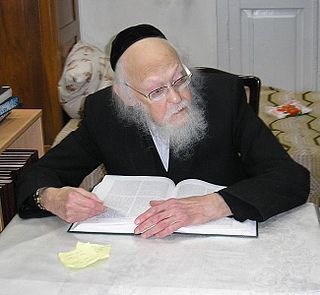Rav (Hebrew: רב) is the Hebrew word for rabbi.
Contents
Rav, RAV, or R.A.V. may also refer to:
Rav (Hebrew: רב) is the Hebrew word for rabbi.
Rav, RAV, or R.A.V. may also refer to:
A rabbi is a spiritual leader or religious teacher in Judaism. One becomes a rabbi by being ordained by another rabbi—known as semikha—following a course of study of Jewish history and texts such as the Talmud. The basic form of the rabbi developed in the Pharisaic and Talmudic eras, when learned teachers assembled to codify Judaism's written and oral laws. The title "rabbi" was first used in the first century CE. In more recent centuries, the duties of a rabbi became increasingly influenced by the duties of the Protestant Christian minister, hence the title "pulpit rabbis", and in 19th-century Germany and the United States rabbinic activities including sermons, pastoral counseling, and representing the community to the outside, all increased in importance.

Abraham Isaac Kook, known as HaRav Kook, and also known by the Hebrew-language acronym Hara'ayah, was an Orthodox rabbi, and the first Ashkenazi Chief Rabbi of British Mandatory Palestine. He is considered to be one of the fathers of religious Zionism and is known for founding the Mercaz HaRav Yeshiva.

The Canada Line is a rapid transit line in Greater Vancouver, British Columbia, Canada, that is part of the SkyTrain system. The line is owned by TransLink and InTransitBC and is operated by ProTrans BC. Coloured turquoise on route maps, it operates as an airport rail link between Vancouver, Richmond, and the Vancouver International Airport (YVR). The line comprises 16 stations and 19.2 kilometres (11.9 mi) of track; the main line runs from Vancouver to Richmond while a 4-kilometre (2.5 mi) spur line from Bridgeport station connects to the airport. It opened on August 17, 2009, ahead of the 2010 Winter Olympics.
Maharam is an acronym of the words ...מורנו הרב רבי מ, a pattern also used for other names. Since many Rabbis were referred to as Maharam, an addition, usually a name of a place or a surname is generally used to differentiate between them.

Yosef Shalom Elyashiv was a Haredi rabbi and posek who lived in Jerusalem. Until his death at the age of 102, Rav Elyashiv was the paramount leader of both Israel and the Diaspora Lithuanian-Haredi community, and many Ashkenazi Jews regarded him as the posek ha-dor, the contemporary leading authority on halakha, or Jewish law.
Hamnuna is the name of several rabbis from the period of the Talmud, among them:

Mordechai Tzemach Eliyahu, was an Israeli rabbi, posek, and spiritual leader.
Ker or KER may refer to:
Rabbi Zeira, known before his semicha as Rav Zeira and known in the Jerusalem Talmud as Rabbi Ze'era, was a Jewish Talmudist, of the third generation of amoraim, who lived in the Land of Israel.
Rapar is a city and a municipality in Kutch district (Kachchh) in the Indian state of Gujarat.
Modern attempts to revive the Sanhedrin are the efforts from 1538 until the present day to renew the Sanhedrin, which was the high court and legislative authority for Jews in ancient times. The Sanhedrin was originally dissolved in 358 by the edict of the Roman emperor Constantius II.
Halevi may refer to:
Rav is the Hebrew generic term for a person who teaches Torah or is a Jewish spiritual guide or a rabbi. For example, Pirkei Avot states (1:6) that:
(..) Joshua ben Perachiah says, "Set up a teacher [RaB] for yourself. And get yourself a friend [HaBeR]. And give everybody the benefit of the doubt."
Gadol or godol is used by religious Jews to refer to the most revered rabbis of the generation.
There are a number of honorifics in Judaism that vary depending on the status of, and the relationship to, the person to whom one is referring.

Yeshivat Har Etzion, commonly known in English as "Gush" and in Hebrew as "Yeshivat HaGush", is a hesder yeshiva located in Alon Shvut, in Gush Etzion. It is considered one of the leading institutions of advanced Torah study in the world and with a student body of roughly 480, it is one of the largest hesder yeshivot in the West Bank.
Abbreviations are a common part of the Hebrew language, with many organizations, places, people and concepts known by their abbreviations.

Kiryat Unsdorf, also known as Sorotzkin, after its main street, is a Haredi Jewish neighborhood in Jerusalem. It is located along the northern edge of the mountain plateau on which central Jerusalem lies. Constructed between 1970 and 1985, Unsdorf is home to several landmark educational centers. A large percentage of residents are American-born.
Rav Huna Kamma was a rabbi of the 2nd century CE and Babylonian Exilarch, allegedly descending from King David. The Seder Olam Zutta refers to him as "Anani", both names being a derivative of "Hananiah". The exact time of his tenure as exilarch is unknown, but it was estimated to have been between 170 and 210 AD.

Iggeret of Rabbi Sherira Gaon, also known as the Letter of Rav Sherira Gaon, and the Epistle of Rav Sherira Gaon, is a responsum penned in the late 10th century in the Pumbedita Academy by Sherira ben Hanina, the Chief Rabbi and scholar of Babylonian Jewry, to Rabbi Jacob ben Nissim of Kairouan, in which he methodologically details the development of rabbinic literature, bringing down a chronological list of the Sages of Israel from the time of the compilation of the Mishnah, to the subsequent rabbinic works, spanning the period of the Tannaim, Amoraim, Savoraim, and Geonim under the Babylonian Exilarchs, concluding with his own time. Therein, Sherira ben Hanina outlines the development of the Talmud, how it was used, its hermeneutic principles, and how its lessons are to be applied in daily life whenever one rabbinic source contradicts another rabbinic source. It is considered one of the classics in Jewish historiography.